Paralytic illness of Franklin D. Roosevelt
The paralytic illness of Franklin D. Roosevelt (1882–1945) began in 1921 when the future President of the United States was 39 years old. His main symptoms were fever; symmetric, ascending paralysis; facial paralysis; bowel and bladder dysfunction; numbness and hyperesthesia; and a descending pattern of recovery. Roosevelt was left permanently paralyzed from the waist down. He was diagnosed with poliomyelitis at the time, but his symptoms are more consistent with Guillain–Barré syndrome (GBS) – an autoimmune neuropathy which Roosevelt's doctors failed to consider as a diagnostic possibility. In 1926, his belief in the benefits of hydrotherapy led him to found a rehabilitation center at Warm Springs, Georgia. He avoided being seen using his wheelchair in public, but his disability was well known and became a major part of his image. In 1938, he founded the National Foundation for Infantile Paralysis, leading to the development of polio vaccines.
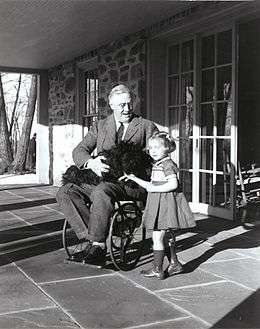
History
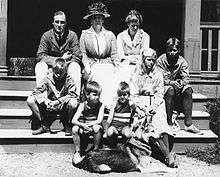
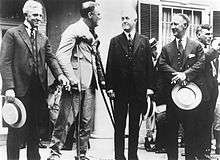
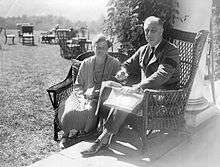
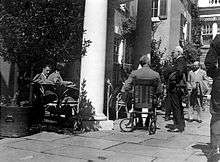
In August 1921, 39-year-old Franklin D. Roosevelt, at the time a practicing lawyer in New York, joined his family at their vacation home at Campobello, a Canadian island off the coast of Maine. As former Assistant Secretary of the Navy, he had spent two weeks in mid-July in Washington, D.C., giving testimony to a Senate committee investigating a Navy scandal.[1]:247–248 On August 5, Roosevelt sailed up the New England coast with his friend and new employer, Van Lear Black, on Black's ocean-going yacht. Among those at Campobello when Roosevelt arrived were his wife Eleanor, their children, his political aide Louis Howe, Howe's wife, and their young son.[2]:40–42
On August 10, after a day of strenuous activity, Roosevelt came down with an illness characterized by fever, ascending paralysis, facial paralysis, prolonged bowel and bladder dysfunction, and numbness and hypersensitivity of the skin.[3][2]:47 Most of the symptoms resolved themselves, but he was left permanently paralyzed from the waist down.
Roosevelt came close to death from the illness. He faced many life-threatening medical problems including the possibility of respiratory failure, urinary tract infection, injury to the urethra or bladder, decubitus ulcers, clots in the leg veins, and malnutrition. Eleanor's nursing care was responsible for Roosevelt's survival.[4]:148–151
Timeline
July 28: Roosevelt visited the Boy Scout Jamboree at Bear Mountain State Park.
August 5–8: Roosevelt traveled to Campobello on board the yacht Sabolo.
August 9: Roosevelt fell into the cold waters of the Bay of Fundy. Later, arrived at Campobello.[3]:233
August 10: Roosevelt spent the day physically active. Afterward, he complained of chills, nausea, and pain in his lower back. He skipped dinner and went to bed. Chills lasted through the night.[1]:252 [5]:235
August 11: In the morning, one of his legs felt weak. Roosevelt had fever. Dr. Eben H. Bennet, a general practitioner in the nearby village of Lubec who had known the Roosevelts for years, visited Roosevelt and diagnosed a bad summer cold. By the evening, one leg was paralyzed, and the other had become weak.[2]:50–51 [6]
August 12: Both legs were paralyzed. His temperature was 102 °F (39 °C). Pain shot through his legs, feet and back.[2]:51, 54 Bennet suggested a consultation with Dr. William W. Keen, an eminent retired neurosurgeon vacationing nearby.[6] Roosevelt's legs were numb. They then became painfully sensitive to touch. He could not pass urine.[6] By evening, his hands were affected.[2]:51
August 13: Roosevelt was paralyzed from the chest down. On that day and the following, his hands, arms, and shoulders were weak. He had difficulty moving his bowels and required enemas.[3]:234 Keen made what Eleanor described as "a most careful, thorough examination".[2]:57–58
August 14: Roosevelt continued to be unable to pass urine for two weeks, and required catheterization. His fever continued for a total of six to seven days.[3]:234 Keen repeated his examination, a bending and prodding that Elliott later termed "excruciating" for his father.[2]:58 Keen diagnosed a clot of blood to the lower spinal cord, and prescribed massage of the leg muscles.[6] Eleanor and Howe began massaging Roosevelt's legs as instructed by Keen, bringing on agonizing pain.[2]:60
August 15: Prostrate and mildly sedated, Roosevelt was occasionally delirious.[2]:60
August 19: Frederic Delano, Roosevelt's uncle, had received a letter from Louis Howe requesting to find a doctor to come see Roosevelt. Delano called his son-in-law, a physician, who recommended he speak to another physician, a Dr. Parker. Parker told Delano that the case sounded like infantile paralysis, and that the leading authorities on the disease were at the Harvard Infantile Paralysis Commission in Boston. Delano caught a train and arrived the next morning.[2]:64
August 20: Dr. Samuel A. Levine was at his office when Delano telephoned Brigham Hospital on Saturday morning. Levine said the senior members of the Harvard Infantile Paralysis Commission, Dr. Lovett and Dr. Peabody, were out of town, but he would try to answer Delano's questions. After reviewing the messages Delano had received from Campobello, Levine thought Roosevelt was suffering from acute poliomyelitis. He urged that a lumbar puncture be done, with the goal of making a diagnosis, but mainly because Levine believed there could be acute benefit from the procedure.[2]:64–65,327 [4]:192 Delano phoned and wrote Eleanor the same day,[3]:239 advising her to stop massaging Roosevelt's legs, and to disregard Keen's advice: "I think it would be very unwise to trust his diagnosis where the Inf. Paralysis can be determined by test of the spinal fluid."[2]:66 Eleanor communicated with Keen, who "very strenuously" resisted the idea of poliomyelitis. Keen asked Lovett to visit Campobello.[2]:66
August 22: Lovett met Levine for dinner. Lovett asked how to distinguish whether paralysis was caused by poliomyelitis or by a clot or lesion of the spinal cord.[4]:183–184
August 23: Lovett left for Campobello.[2]:68
August 24: Lovett saw Roosevelt and performed a "more or less superficial" examination since Roosevelt was highly sensitive to touch. The arms were weak; the bladder was paralyzed; the left thumb indicated atrophy. Roosevelt could not stand or walk, and Lovett documented "scattered weakness, most marked in the hips".[2]:68
August 25: Roosevelt's temperature was 100 °F (38 °C). Both legs were paralyzed. His back muscles were weak. There was also weakness of the face and left hand. Pain in the legs and inability to urinate continued.[3]:234 After a brief conference with Keen, Lovett saw Roosevelt. Lovett informed him that the "physical findings" presented a "perfectly clear" diagnosis of poliomyelitis.[2]:69–70 Lovett ordered an end to massage, which had no benefit and caused pain, and recommended a trained nurse to care for Roosevelt.[2]:75–76
September 1: Roosevelt was still unable to urinate. His leg pain continued.[4]:3
September 14: Roosevelt was transported to New York, by boat and train, a long and painful journey.
September 15: Roosevelt was admitted to Presbyterian Hospital in New York City for convalescence, under the care of Dr. George Draper, an expert on poliomyelitis and Roosevelt's personal physician. Lovett continued to consult from Boston.[2]:76 There was pain in the legs, paralysis of the legs, muscle wasting in the lower lumbar area and the buttocks, weakness of the right triceps, and gross muscle twitching in both forearms.[3]:234
October 28: Roosevelt was transferred from Presbyterian Hospital to his house on East 65th Street. His chart still read "not improving". [2]:110
Later: Roosevelt exercised daily. His hamstrings tightened, and his legs were encased in plaster to straighten them by degrees.[5]:238 There was gradual recovery, but he remained paralyzed from the waist down.
Diagnosis
After falling ill, Roosevelt was seen by four doctors. Eben Homer Bennet, the Roosevelt family doctor, diagnosed a heavy cold. William Keen, a retired neurosurgeon, thought Roosevelt had a blood clot. Robert Lovett, an expert on the orthopedic management of children paralyzed from poliomyelitis, diagnosed "infantile paralysis", as did George Draper, Roosevelt's personal physician.
Roosevelt's physicians never mentioned Guillain–Barré syndrome (GBS) in their communications concerning Roosevelt's case, indicating that they were not aware of it as a diagnostic possibility.[4]:204 All reports before 1921 of what is now called GBS were by European physicians, in European journals. The result was that very few American physicians knew that GBS was a separate disease. For example, Lovett mistakenly believed that Landry's ascending paralysis, now termed GBS, was one of the clinical presentations of paralytic polio.[4]:203 In 1921, an American physician would assume that if an individual developed a sudden, non-traumatic flaccid paralysis, it was due to paralytic polio. The concept of GBS as a separate disease was not widely accepted in the United States until after the Second World War.[4]:232
Warm Springs
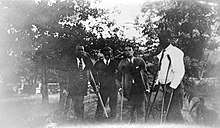
Roosevelt first traveled to Warm Springs, Georgia, on October 3, 1924. For many years to come Warm Springs would be where he would retreat in comfort for hydrotherapy. On April 29, 1926, he bought the center with the intention of making it into a rehabilitation center for polio patients.[7]:33–34 One of Roosevelt's primary goals was to get the American Orthopedic Association to endorse the resort, but he was rejected because there was no real progress in physical health.[2]:222–226
Governor and President
In 1929, Roosevelt was elected Governor of New York and moved into the Governor's Mansion in Albany. Before he moved in, the mansion was made wheelchair-friendly with ramps and an elevator.[7]:68–87
Roosevelt won the 1932 presidential election in a landslide and became the first (and as of 2019 the only) physically disabled person to be President of the United States. Before he moved into the White House, ramps were added to make it wheelchair-friendly. Any pictures of the President were taken at certain angles and at a distance.[7]:88–105
Efforts to rehabilitate
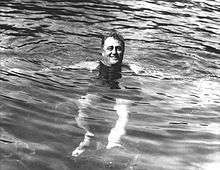
Roosevelt was totally and permanently paralyzed from the waist down, and unable to stand or walk without support.[8] For the next few months, he confined himself to indoor pursuits, including resuming his lifelong hobby of stamp collecting.[9] In December 1921, after he had recuperated for several months, a physiotherapist began working with him to determine the extent of the damage. He was able to perform small exercises on his own, moving one muscle and then another.[10] He was fitted with heavy steel braces that locked at the knee and provided enough stability that he could stand with crutches. In 1922, at Springwood, he worked diligently to make his way across the room. He set himself the goal of getting down the long driveway, managing to do it once, but never trying again.[5]:241
In October 1922, Roosevelt visited his law office at the Equitable Building, where a welcome-back luncheon had been arranged. The chauffeur assisting him failed to brace the tip of his left crutch and Roosevelt fell onto the highly polished lobby floor. Laughing, he asked two young men in the crowd of onlookers to help get him back on his feet. After the luncheon, he told friends it was a "grand and glorious occasion". He did not return to his office for two months.[5]:245
Roosevelt believed that warmth and exercise would help rebuild his legs. He bought a run-down 71-foot (21.6 m) houseboat and, in February 1923, sailed to Florida with friends and a small crew. Eleanor found it dull and left, but Roosevelt sailed for weeks, fishing and spending time with a succession of friends who came to visit. He designed a pulley system that lowered him into the water to swim. In May 1923, Lovett documented no overall improvement over the preceding year, but Roosevelt would not accept his doctors' determination that further progress was unlikely. He tried a range of therapies and made two more voyages on his houseboat, but his efforts had no effect.[5]:247–249
"Between 1925 and 1928, Franklin would spend more than half his time—116 of 208 weeks—away from home, struggling to find a way to regain his feet," wrote biographer Geoffrey Ward. "Eleanor was with him just 4 of those 116 weeks, and his mother was with him for only 2. His children hardly saw him."[5]:248
Roosevelt lost the use of his legs and two inches of height, but the subsequent development of the rest of his body gave him a robust physique, and he enjoyed many years of excellent health. Jack Dempsey praised his upper-body musculature, and Roosevelt once landed a 237-pound (107.5 kg) shark after fighting it on his line for two hours.[11]:241, 266–267
With his physiotherapist at Warm Springs, Roosevelt laboriously taught himself to walk short distances while wearing iron braces on his hips and legs, by swiveling his torso. For this "two-point walk", he would grip the arm of a strong person with his left hand, and brace himself with a cane in his right.
Social impact
Roosevelt was the United States' first disabled president, so there has been discussion concerning how he handled his health. Disability advocate Hugh Gallagher posited that Roosevelt was desperate to appear able-bodied. When discussing Roosevelt's limited use of a wheelchair in public, Gallagher stated, "This was not by accident. It was a strategy that served to minimize the extent of his handicap, to make it unnoticed when possible and palatable when it was noticed."[7]:xiv Historian James Tobin argued that Roosevelt used his disability to his advantage. Tobin stated, "But he could, instead, show himself to be something he had never been seen as before: a fighter and, and better yet, an underdog; not a man to pity, not a man to envy, but a man to cheer."[2]:273 Despite any controversy, Roosevelt has become an inspirational figure for disabled people around the world. The Roosevelt Memorial in Washington, D.C., includes a statue of Roosevelt in a wheelchair.
Public awareness

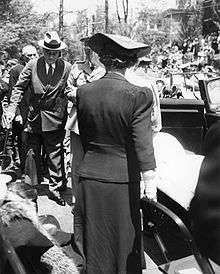
Roosevelt was able to convince many people that he was getting better, which he believed was essential if he was to run for public office again. In private he used a wheelchair, but was careful not to be seen using it in public, although he sometimes appeared on crutches. He usually appeared in public standing upright, supported on one side by an aide or one of his sons. For major speaking occasions, an especially solid lectern was placed on the stage so that he could support himself on it; as a result, in films of his speeches, Roosevelt can be observed using his head to make gestures because his hands were gripping the lectern. He might raise one hand to gesture, but his other hand held the lectern.
His public appearances were choreographed to avoid the press covering his arrival and departure, which would have shown him getting into or out of a vehicle. When possible, his vehicle was driven into a building's parking garage for his arrivals and departures. On other occasions, the vehicle would be driven onto a ramp to avoid steps, which Roosevelt was unable to ascend. When that was not practical, the steps would be covered with a ramp with railings, with Roosevelt using his arms to pull himself upward. When traveling by train, Roosevelt often appeared on the rear platform of the presidential railroad car. When he boarded or disembarked, the private car was sometimes shunted to an area of the railroad yard away from the public for reasons of security and privacy. When Roosevelt's train used a ramp and the president was on a publicly known trip, he insisted on walking on the ramp no matter how difficult.
Journalist John Gunther reported that in the 1930s, he often met people in Europe, including world leaders, who were unaware of Roosevelt's paralysis.[11]:239 David Brinkley, who was a young White House reporter in World War II, stated that the Secret Service actively interfered with photographers who tried to take pictures of Roosevelt in a wheelchair or being moved about by others. The Secret Service commonly destroyed photographs they caught being taken in this manner; however, there were occasional exceptions.[8][12][13]
When Roosevelt addressed the Congress in person on March 1, 1945, about a month before his death, he made public reference to his disability for almost the first time in 20 years.[11]:36 "I hope that you will pardon me for this unusual posture of sitting down," Roosevelt began, "but I know you will realize that it makes it a lot easier for me not to have to carry about ten pounds of steel around on the bottom of my legs."[14]
Legacy
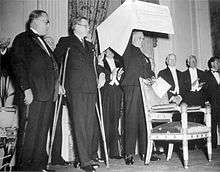
March of Dimes
On January 3, 1938, Roosevelt founded the National Foundation for Infantile Paralysis, now known as the March of Dimes.[15] Basil O'Connor, an attorney and close associate of Roosevelt, helped establish the foundation and was its president for more than three decades.[15] The organization's annual fundraising campaign coincided with Roosevelt's birthday on January 30. The organization initially focused on the rehabilitation of victims of paralytic polio and supported the work of Jonas Salk and others that led to the development of polio vaccines. Today, the March of Dimes focuses on preventing premature births, congenital disabilities, and infant mortality.[15]
Because he founded the March of Dimes, a dime was chosen to honor Roosevelt after his death. The Roosevelt dime was issued on January 30, 1946.[16][17]
Roosevelt Warm Springs Institute for Rehabilitation
Roosevelt's center at Warm Springs operates today as the Roosevelt Warm Springs Institute for Rehabilitation, a comprehensive rehabilitation facility operated by the state of Georgia.[18] A center for post-polio treatment, it provides vocational rehabilitation, long-term acute care, and inpatient rehabilitation for amputees and people recovering from spinal cord injuries, brain damage, and stroke.[19][20]
Retrospective diagnosis
Analysis of symptoms
A 2003 peer-reviewed study of Roosevelt's paralytic illness, using three diagnostic methods – pattern recognition, reconstructing the pathogenesis, and Bayesian analysis – favored a diagnosis of Guillain–Barré syndrome (GBS) over poliomyelitis.[3] For the Bayesian analysis, the best estimate of the annual incidence of GBS was 1.3 per 100,000. For paralytic polio in Roosevelt's age group, an annual incidence of 1.0 per 100,000 was used. The paralytic polio rate was derived from the exceptionally severe polio epidemic that struck New York City in 1916, to tilt the odds in favor of polio. The prior probability of paralytic polio in Roosevelt's age group in the United States in 1921 was likely much lower because paralytic polio was at one of its lowest ebbs in the Northeastern region of the country at that time.[4]:123 [21][2]:26 In July 1921, three cases were reported in New Jersey.[22] By late August some 100 cases were reported in the state of New York.[23] Based on the incidence rates for GBS and paralytic polio, and symptom probabilities from the medical literature, Roosevelt's symptoms were analyzed by Bayesian analysis to obtain posterior probabilities, as listed below.[3][4]:125
Six of eight symptoms favored GBS, with the posterior probability of GBS shown for each:
- 98% - Roosevelt's paralysis was symmetric and ascending, and progressed more than four days, whereas the paralysis in poliomyelitis is typically asymmetric, variable in its ascent or descent, and usually progresses for only two to four days. A review of the medical research literature revealed only one report of paralytic polio with a symmetric, ascending paralysis.
- 98% - Roosevelt's numbness and hyperesthesia rarely if ever occur in paralytic polio (motor neurons affected), but are common in GBS (sensory neurons also affected).
- 98% - A consistent descending pattern of recovery from paralysis is absent in paralytic polio, but common in GBS.
- 97% - Facial paralysis, as Roosevelt had, in the absence of other cranial nerve abnormalities, is not consistent with a polio diagnosis, but is common in GBS.
- 93% - Roosevelt's prolonged bladder and bowel dysfunction are rare in paralytic polio, since polioviruses do not attack autonomic nerves, but are common in GBS.
- 93% - Meningismus (neck stiffness), a characteristic feature of paralytic polio, was absent in Roosevelt's case.
Two of eight symptoms favored polio, with the posterior probability of polio shown for each:
- 99% - Roosevelt had fever up to 102 °F (38.9 °C), which is rare in GBS, although the pattern of the fever that Roosevelt experienced was atypical of paralytic polio.
- 72% - Roosevelt had permanent paralysis, which occurs in about 50% of paralytic polio survivors, and only about 15% of cases of GBS.
Using all eight symptoms in a Bayesian analysis, based on disease incidence rates and symptom probabilities from the medical literature, the overall probability that Roosevelt had GBS is over 99%.[4]:242–250
When might exposure have occurred?
It is possible Roosevelt was exposed to an infectious agent at the Boy Scout Jamboree in late July. The two-week interval before the onset of his neurological illness was in keeping with both the incubation period of poliomyelitis,[2]:13–30 and with exposure to an infectious agent leading to GBS.[4]:183 There are no reports that any scouts or personnel at the camp were ill around the time of Roosevelt's visit. In 1912 and 1915, Roosevelt had illnesses compatible with Campylobacter jejuni, a major causative agent of GBS.[4]:145
Was Roosevelt predisposed to polio?
It has been stated that Roosevelt may have been predisposed to paralytic polio by genetic inheritance.[2]:40 However, such a genetic predisposition has never been discovered.[4]:195 Several authors have stated that Roosevelt was more vulnerable to polio since he was raised on an isolated family estate[10] and had little contact with other children until he entered Groton at age 14. However, Roosevelt was not a "boy in a bubble". He had many possible exposures to polioviruses before 1921. Most polio cases are asymptomatic or a mild illness. Yet those asymptomatic individuals can transmit the viral infection.[4]:109 When the prior probability of paralytic polio was artificially made 100-fold higher, to 99.4%, overall Bayesian analysis of Roosevelt's symptoms still greatly favored GBS (99.97% posterior probability). Roosevelt's symptoms are typical of GBS, not of paralytic polio, so they overwhelm the initial prior probability.[4]:246
Was a lumbar puncture done?
A 2014 book argued that a lumbar puncture was done, based on excerpts from an "unpublished note" by Dr. Samuel A. Levine of the Harvard Infantile Paralysis Commission. The book stated, "Levine's private note indicates that Dr. Lovett did examine the cerebrospinal fluid and knew very well that a high level of white blood cells was consistent with poliomyelitis... If Lovett had discovered a low white blood cell count, he would have doubted that poliomyelitis was the cause of Roosevelt's illness. Yet Lovett wrote George Draper that "I thought [the diagnosis] was perfectly clear as far as the physical findings were concerned.""[2]:327–328
A 2017 book finally published the note. Based on the full text, the note was not found to support the idea that a spinal tap was performed, because:
- The note, written many years after 1921, had many errors.
- Levine never saw Roosevelt.
- Levine did not mention who did the procedure, or the results.
- Lovett had made it clear he would not do the procedure.
- None of Roosevelt's physicians at Campobello were equipped to do the procedure.
- "Physical findings" means information gained from a physical examination of the patient. Lovett described many "physical findings": hyperesthesia, facial paralysis, etc. But neither he, any of Roosevelt's other physicians at Campobello, Roosevelt, Eleanor, nor any of Roosevelt's associates ever said that a spinal tap was done.[4]:183–201
The 2017 book went on to say: "Given the invasive nature of a spinal tap, and the difficulty that would have occurred doing the procedure on a patient in FDR’s condition, it seems highly unlikely that a direct observer would have failed to mention anything about it... Even if a spinal tap had been performed, it would have been done at the earliest about 15 days after the onset of the neurological illness, around when Lovett first saw Roosevelt... One should keep in mind that the classical distinction between paralytic polio and GBS, the concentrations of leukocytes and total protein in CSF, blurs after the first several days of the onset of paralysis in both diseases."[4]:193,198
Could the outcome have been changed?
"In any event, there was no cure for either disease in 1921," wrote biographer Jonathan Alter.[24] However, Levine mistakenly thought that the main benefit of a spinal tap, if done, would be to improve the outcome by lowering elevated CSF pressure.[4]:192 Even today, some authors mistakenly believe that Roosevelt's paralysis, assuming a polio diagnosis, could have been prevented with early intervention.[2]:45,49,62,66 However, there is no objective evidence that a spinal tap lessens the possibility of paralysis in polio. And it is unlikely Roosevelt's physicians would have tried human serum injections into the CSF, or that such injections would have helped. Lovett did not think the injections were useful, and there were alarming meningeal symptoms associated with them, probably secondary to the formation of antigen-antibody complexes.[4]:199–200 Concerning GBS, virtually all of the effective measures that are currently standard practice for the medical management of GBS were not developed until many decades after Roosevelt's 1921 illness, so Roosevelt's prognosis would not have improved even if GBS had been diagnosed.[3]:238
See also
- Polio Hall of Fame
- Sunrise at Campobello (1958 play)
- Sunrise at Campobello (1960 film, based on the 1958 play)
- Eleanor and Franklin (1976 television miniseries)
- Warm Springs (2005 television film)
References
- Collier, Peter; Horowitz, David (1994). The Roosevelts: An American Saga. New York: Simon & Schuster. ISBN 0671652257.
- Tobin, James (2013). The Man He Became: How FDR Defied Polio to Win the Presidency. Simon & Schuster. ISBN 0743265165.
- Goldman AS, Schmalstieg EJ, Freeman DH, Goldman DA, Schmalstieg FC (2003). "What was the cause of Franklin Delano Roosevelt's paralytic illness?" (PDF). Journal of Medical Biography. 11 (4): 232–40. doi:10.1177/096777200301100412. PMID 14562158. Retrieved 2017-07-04.
- Goldman, Armond S.; Goldman, Daniel A. (2017). Prisoners of Time: The Misdiagnosis of FDR's 1921 Illness. EHDP Press. ISBN 978-1939824035.
- Ward, Geoffrey C.; Burns, Ken (2014). The Roosevelts: An Intimate History. New York: Alfred A. Knopf. ISBN 9780307700230.
- Ditunno JF, Herbison GJ (2002). "Franklin D. Roosevelt: diagnosis, clinical course, and rehabilitation from poliomyelitis". Am J Phys Med Rehabil. 81 (8): 557–66. doi:10.1097/00002060-200208000-00001. PMID 12172063.
- Gallagher, Hugh (1985). FDR’s Splendid Deception. New York: Dodd, Mead & Company, Inc. ISBN 0918339502.
- Pressman, Matthew (July 12, 2013). "The Myth of FDR's Secret Disability". Time. Retrieved Aug 12, 2013.
- G. Wayne Clough (November 2009). "From the Castle - FDR's Stamps". Smithsonian.
- "Roosevelt's Polio Wasn't A Secret: He Used It To His 'Advantage'". Fresh Air. NPR. November 25, 2013. Retrieved 2015-09-25.
- Gunther, John (1950). Roosevelt in Retrospect. New York: Harper & Brothers. OCLC 466356.
- "THE PRESIDENCY: New Quarters". Time. December 17, 1934.
- Goldberg, Richard T. (1981). The Making of Franklin D. Roosevelt: Triumph Over Disability. Cambridge, Massachusetts: Abt Books. ISBN 9780890115640.
- "Address to Congress on Yalta (March 1, 1945)". Mar 1, 1945. Retrieved Aug 12, 2013.
- Baghdady, Maddock J. (2008). "Marching to a Different Mission" (PDF). Stanford Social Innovation Review: 60–65. Retrieved 2015-09-25.
- Barrett, William P. "March of Dimes' Second Act". Forbes, November 19, 2008.
- Reiter, Ed (June 28, 1999). "Franklin D. Roosevelt: The Man on the Marching Dime". Professional Coin Grading Service. Archived from the original on August 20, 2008. Retrieved 2015-09-25.
- "Roosevelt Warm Springs". Georgia Vocational Rehabilitation Agency. Archived from the original on 2003-09-19. Retrieved 2015-09-28.
- McKenna, M.A.J. (April 12, 2005). "Reflections on Warm Springs". The Atlanta Journal-Constitution.
- Wilkinson, Jack (October 8, 2006). "Warm Springs artisans fought polio's damage". The Atlanta Journal-Constitution.
- "History of Polio". The History of Vaccines. College of Physicians of Philadelphia. Retrieved 2015-10-03.
- "Find Infantile Paralysis; Three Cases Develop in Paterson". The New York Times. July 26, 1921. Retrieved 2015-10-03.
- "Infantile Paralysis is Spreading Up State". The New York Times. August 23, 1921. Retrieved 2015-10-03.
- Alter, Jonathan (2007). The Defining Moment: FDR's Hundred Days and the Triumph of Hope. New York: Simon & Schuster. p. 355. ISBN 9780743246019.
